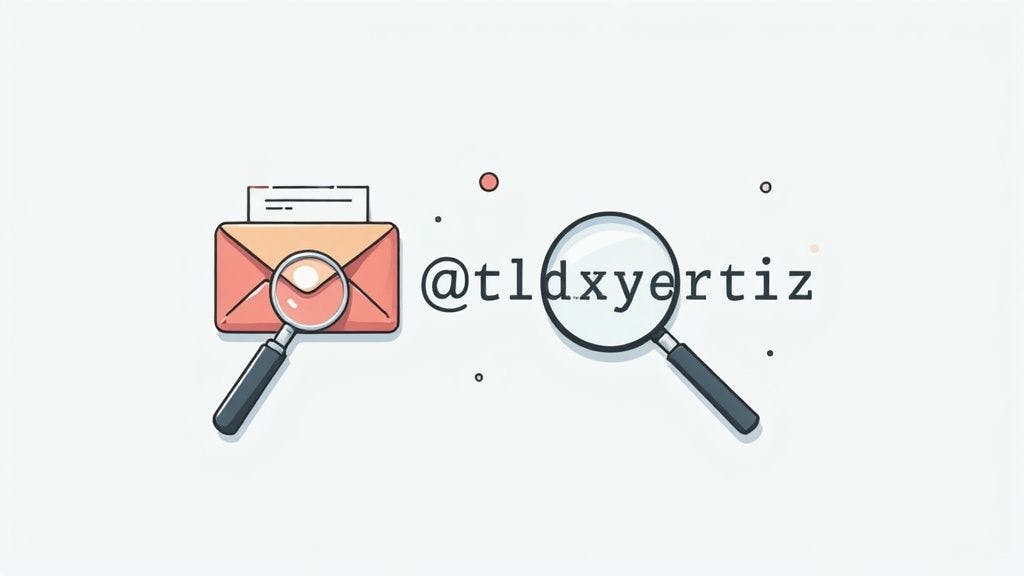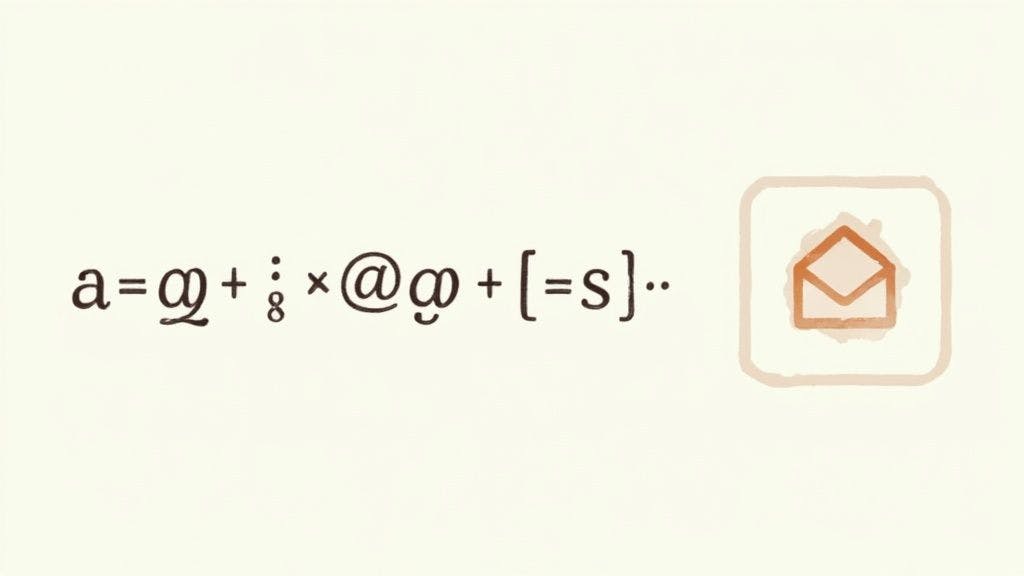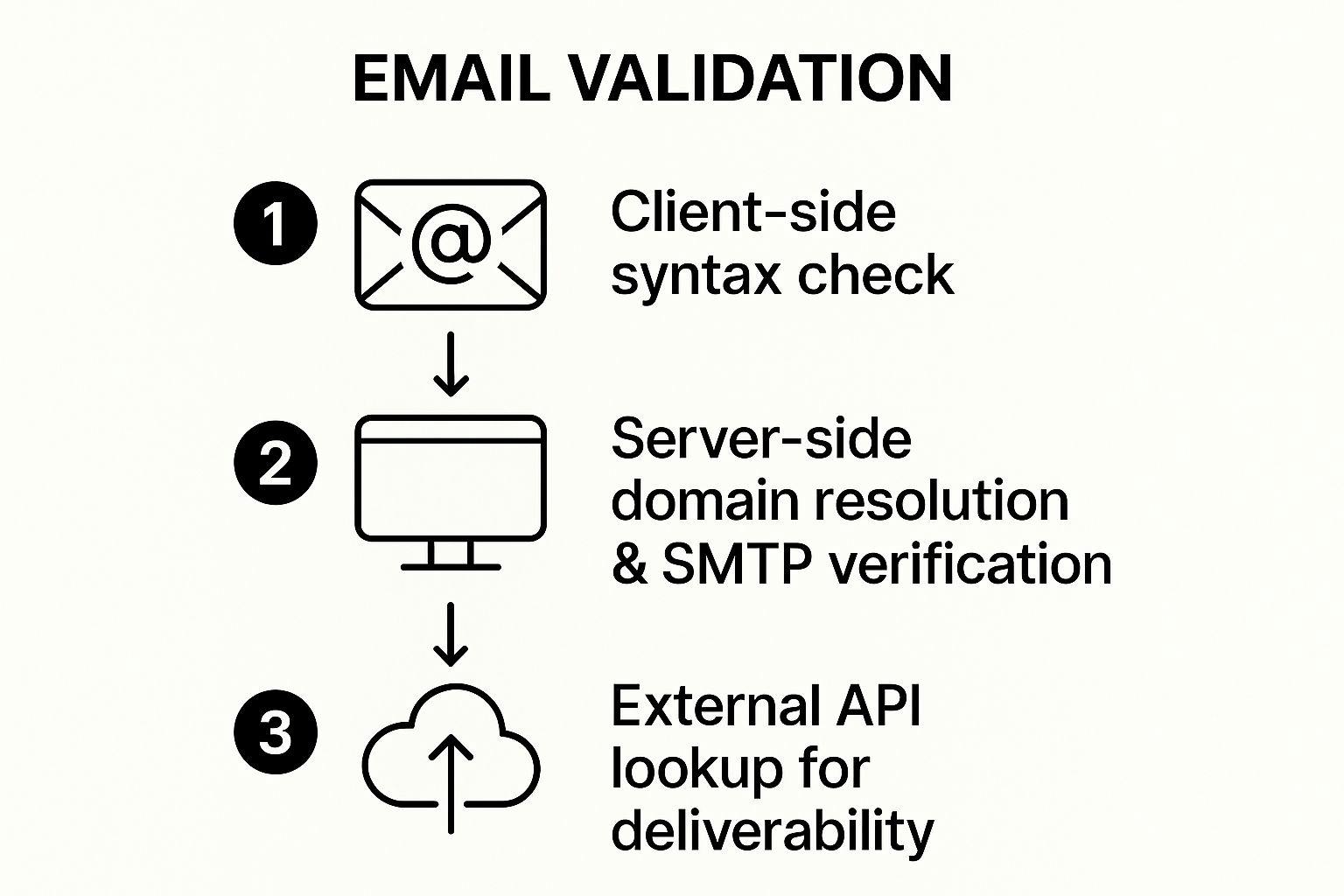Why Email Validation Makes or Breaks Your Campaigns
Let's be honest, email validation isn't the most exciting topic. But trust me, it's crucial. I've seen firsthand how neglecting it can absolutely wreck your sender reputation, damaging those hard-earned relationships with ISPs. Think of it like this: you spend months building bridges with these providers, and invalid emails are like termites, quietly chewing away at the foundations.
This damage goes way beyond just a high bounce rate. Invalid emails quietly sabotage your domain authority and trigger those sneaky hidden spam filters. It's kind of like a credit score for your email. Each bad address is a missed payment, lowering your standing with the email gatekeepers. I worked with a B2B SaaS company that learned this the hard way. Their deliverability plummeted by 20% after just one campaign with too many invalid addresses. They thought they were saving money by skipping validation, but it ended up costing them way more in lost leads.
Plus, different industries have their own validation quirks. What works for a B2B SaaS business might not work at all for an e-commerce brand. E-commerce often sees a lot of temporary emails for one-time discounts, making validation trickier. B2B, meanwhile, grapples with old corporate addresses due to employee turnover. Knowing these nuances is key.
The Real Cost of Invalid Emails
So, a few bounced emails, what's the big deal, right? Wrong. The cost goes far beyond just a lost message. High bounce rates tell email providers that your list is neglected. This can land you on a blacklist, which is like getting a scarlet letter in the email world. Getting off a blacklist is a nightmare. Want to learn more? Check out our guide on what is email verification.
Validating emails is also essential for high deliverability. Look at B2B email – they're hitting around 98.16% delivery, showing how validation gets your messages where they need to go. For more on this, check out these email deliverability statistics. This really highlights how crucial accurate email validation is for your overall email marketing strategy.
Why Proactive Validation Is Your Best Strategy
Investing in proper email validation upfront saves you tons of trouble later. It's like regular car maintenance: a small cost now prevents a major breakdown later. Solid validation builds a strong foundation for deliverability, helping you avoid spam filters and blacklists. This means more emails hitting your target audience, boosting campaign performance and ROI. So, when you're planning that next email campaign, remember: validation isn't an extra step, it's an investment in your future success.
Understanding Regional Email Behavior That Changes Everything
I've managed global email campaigns for a while now, and let me tell you, one of the biggest mistakes I see is treating all email addresses the same. It just doesn't work! Regional differences are huge. How people use email, how internet service providers (ISPs) handle them...it all changes depending on where in the world you're sending. Europeans interact with email differently than North Americans. Asian markets, with their mobile-first mindset, throw another wrench in the works. So, what can you do?
Adapting Your Validation Strategy for Different Markets
The key is to adapt. Your validation approach needs to be tailored to your target audience's location. This means getting familiar with each region's unique ISP landscape and understanding which validation techniques work best there. For instance, some disposable email domains are common in certain areas but practically non-existent in others. If you don't pay attention to these local trends, you're wasting time and effort.
Cultural factors also play a surprisingly big role. How often people check their email, how much marketing email they're willing to tolerate, even whether they prefer personal or professional addresses—it all varies by region. Ignoring these cultural nuances can really hurt your campaign's success. Take a look at this: Europe has the highest inbox placement rate, around 91%. Compare that to the Asia-Pacific region, which sits closer to 78%. These regional differences really highlight how important email validation is. Want more details on global deliverability? Check out this resource on global email deliverability.
To better illustrate these regional variations, let's examine some key market differences:
Regional Email Deliverability Rates by Market
| Region | Inbox Placement Rate | Key Validation Considerations | Recommended Approach |
|---|---|---|---|
| North America | ~85% | High prevalence of disposable emails, strict spam filters | Combine syntax checks with real-time verification |
| Europe | ~91% | GDPR compliance crucial, preference for business emails | Prioritize GDPR-compliant validation tools |
| Asia-Pacific | ~78% | Mobile-first environment, diverse ISP landscape | Focus on SMTP verification and mobile-optimized emails |
| Latin America | ~82% | Growing market with varied infrastructure, language considerations | Implement flexible validation covering different email formats |
This table gives you a snapshot of how inbox placement differs and what factors you should prioritize for validation in each region. As you can see, a nuanced strategy is key.
Navigating Regional Challenges: GDPR and Beyond
Europe adds another layer of complexity with GDPR compliance. Your validation methods must align with these regulations, especially regarding data collection. The Asia-Pacific region, with its diverse ISPs and infrastructure, requires a flexible approach. Think about it: You need a system that can handle a wide range of email behaviors. Looking for tips on crafting effective email links? This article on Email Links That Actually Work offers some helpful strategies.

The bottom line? A one-size-fits-all approach to email validation just won’t work in a globalized world. By understanding and adapting to regional differences, you can drastically improve your deliverability rates and make your email marketing far more effective. You've put effort into your message, so make sure it actually lands in the right inbox, no matter where your audience is.
Mastering Syntax Validation Without the Technical Overwhelm
Let's talk email validation. Forget dense RFC specs; we need a practical approach that catches real problems without blocking legitimate subscribers. I've seen businesses lose customers due to overly strict validation, so let's find a balance.
Understanding Common Email Patterns (and the Quirks)
You see all kinds of email formats. The basic `[email protected]` is easy, but what about international domains or those odd (but valid) addresses your competitors are rejecting? Basic checks often miss these edge cases.

This Wikipedia screenshot shows the standard email format. It's simple, right? But the allowed characters within each part are trickier than you might think, leading to valid and invalid variations.
Finding the Right Balance: Thorough Yet Practical
The goal isn’t perfect technical validation but one that works for you. Strict validation might give you a pristine list, but at what cost? Too lenient, and your bounce rate skyrockets, hurting your sender reputation. It’s a balancing act.
Real-World Examples from the Trenches
I had a client rejecting emails with plus addressing (like `[email protected]`). Turns out, their target audience used this for filtering. Adjusting the rules saved a significant portion of their subscriber list. Know your audience and their email habits!
Implementing Robust Syntax Checking: A Practical Guide
Solid syntax checking doesn't have to be a nightmare. Start with common patterns, then refine based on your audience. Targeting international users? Account for Unicode. The goal? Catch typos and fakes without blocking real people. This practical, flexible approach has kept lists clean without unnecessary rejections in my experience.
Domain and MX Record Verification That Actually Delivers Results
So, you want to validate email addresses? Going beyond just checking if an address looks right takes us into domain verification. This is where it gets interesting, and where a lot of validation attempts fall flat. I've spent years figuring out the best way to do this for large email campaigns, and I'm happy to share what really works. Forget theory; let's talk practical solutions.
Identifying Catch-All Domains: Accepting Everything, Delivering Nothing
One tricky thing about domain verification is dealing with catch-all domains. These domains accept any email address, even if it doesn't exist. Think of it as a giant net catching everything, including a ton of junk. This is a problem because a catch-all domain often says "yes" to verification attempts, even for fake addresses. That gives you false positives – a seemingly clean list, but your deliverability tanks because messages vanish into the void.
These false positives lead to a frustrating situation: your email marketing metrics might look okay on the surface, but your actual impact is severely limited because a significant portion of your messages aren't reaching real users. This can skew your open rates, click-through rates, and ultimately, your return on investment. It’s like throwing darts blindfolded – you might hit the board, but you’re unlikely to hit the bullseye.
Distinguishing Between Temporary Hiccups and Permanent Problems
Another challenge is telling the difference between temporary domain problems and permanent ones. A domain might be down for a bit because of a server issue or something. It doesn't mean the email addresses are invalid. It's like a road closure – you can't get through now, but the destination's still there. Your validation strategy needs to spot these temporary blocks and not toss out good addresses. Smart retry mechanisms can save you from discarding valuable contacts.
Imagine you’re trying to reach a customer with a time-sensitive offer. If your validation system flags their address as invalid due to a temporary server issue, you miss the opportunity to connect with them. Implementing a retry mechanism gives you a second chance to deliver that message when the server comes back online, maximizing your chances of conversion.
Handling the Edge Cases: Forwarding Addresses and Beyond
And then you've got edge cases, like forwarding addresses. An address might be valid – it exists and can receive mail – but it forwards to another address, which could be invalid. This chain of uncertainty can really mess with deliverability. It’s like playing a game of telephone – the message might get garbled along the way, or it might not arrive at all. You need to recognize forwarding and assess if it's a risk to your campaigns.
For example, if a user has set up forwarding from a work address to a personal account, and that personal account is no longer active, your message will bounce. Identifying these forwarding scenarios through proper email verification allows you to proactively reach out to the customer for an updated email address, ensuring they continue to receive your communications.
Interpreting Domain Responses and Refining Your Strategy
Understanding different domain responses is key for good email validation. Some domains are super strict with filtering; others are more open. You need to interpret these signals and make smart choices about those borderline cases. It's not always clear-cut, and knowing when to be careful vs. when to take a calculated risk is a big deal. Think of it like navigating a complex maze – the more you understand the layout, the better your chances of finding the correct path.
To help you navigate this, let’s take a look at the different responses you might encounter during domain validation:
Email Domain Validation Response Types
| Response Type | What It Means | Validation Action | Deliverability Impact |
|---|---|---|---|
| 250 OK | Address exists and is accepting mail | Accept | Positive |
| 550 No such user | Address does not exist | Reject | Negative - Bounce |
| 450 Mailbox unavailable | Temporary issue, try again later | Retry | Potentially negative - Delay |
| 251 User not local, will forward | Email will be forwarded | Evaluate | Uncertain, depends on the forwarding address |
This table gives you a quick overview of the different response codes and their implications. Notice how a "251 User not local" response requires further evaluation. This highlights the importance of understanding the nuances of email domain responses.
By mastering domain and MX record verification, you move past superficial checks to truly understand email deliverability. This is how you build a clean, effective email list that delivers results.
SMTP Verification Without the Technical Headaches
SMTP verification is where email validation gets serious, but it can also be a bit of a minefield. Nobody wants to end up blocked by spam filters, so let's explore how to do it the right way. Trust me, I've learned from experience, and I'm happy to share some tips to help you avoid the pitfalls. It all comes down to simulating email delivery without actually sending a message.
Simulating Email Delivery: The Smart Approach
Imagine checking if someone's home by knocking on their door. You're not barging in, you're just listening for a response. That's essentially what simulated email delivery does. You connect to the mail server and initiate a delivery, but stop short of actually sending the email. This allows you to see how the server responds without setting off spam alarms or cluttering inboxes with test messages.
By interpreting the server's response, you can determine the validity of an email address. A positive response is a good sign; a negative response suggests a problem. It's a quick, efficient way to confirm deliverability without sending actual mail. Think of it as a quick confirmation – a simple "yes" or "no" – before embarking on the full journey.
Respecting Mail Servers: Avoiding the Blacklist
Mail servers are designed with protective mechanisms, like rate limiting, to prevent abuse. If you bombard a server with too many requests, you'll look suspicious, like a spammer, and get blocked. So, pace yourself and be respectful of the server's resources.
Timing is also key. A temporary server glitch doesn't automatically mean an email address is invalid. Give it some time and try again later. For a more in-depth understanding of these nuances, take a look at our guide on SMTP email checkers. It provides a detailed look at implementing these checks effectively.

When to Use (and When Not to Use) SMTP Verification
SMTP verification is a valuable tool, but it's not always required. Simple syntax and domain checks might be sufficient for basic validation needs. However, if accuracy is crucial, particularly with high-value email lists, SMTP is worth the effort. It's a powerful technique, but like any specialized tool, it's best used strategically.
Integrating SMTP into Your Workflow
Adding SMTP verification to your workflow doesn't have to be a major undertaking. Numerous tools and libraries are available to simplify the process. The goal is to find a good balance between thoroughness and efficiency – accurate validation without creating bottlenecks. Think of it as adding a security checkpoint: It adds a step, but it ultimately ensures smoother operations down the line. Use SMTP wisely, understand its strengths and limitations, and you'll significantly boost your email validation efforts.
Integrating AI-Powered Validation APIs Like a Professional
Email validation can be a real headache. Luckily, AI-powered services can take a lot of the pain away. I've spent quite a bit of time integrating these APIs, so I'll give you the lowdown on what actually works, not just the marketing fluff. Picking the right service means looking past the buzz and focusing on what truly matters: accuracy, speed, and cost.
Evaluating AI-Powered Email Validation Services
Thinking about using an AI-driven validation API? Excellent! But don't get fooled by the hype. Look beyond the marketing speak and delve into the real metrics. What accuracy rates are they claiming? A high percentage of correctly identified valid and invalid emails is crucial. Then, consider processing speed. How quickly can the API handle your requests, especially large volumes? Finally, think about cost-effectiveness. A cheaper service might seem tempting, but if it compromises accuracy, you'll lose money down the line.
This screenshot from VerifyRight's website highlights their developer-friendly approach to API integration. The clean design and easy-to-find API documentation speak volumes about their focus on practical implementation.
Handling API Responses and Building Robust Error Handling
Integrating an API isn't just about sending requests and hoping for the best. It's about knowing what to do with the responses. You need a plan for "valid," "invalid," and "unknown" results. Even more importantly, you need rock-solid error handling. What if the API service has a temporary outage? Your validation process shouldn't come to a screeching halt. Implement proper error handling, like retries and fallbacks, to keep things running smoothly, even if the API stumbles.
Optimizing API Usage and Managing Costs
Using an API effectively means understanding its boundaries. Most services have usage limits or rate restrictions. Exceeding these can slow down your validation process and even lead to extra charges. It's a bit like your phone's data plan—use it wisely to avoid overage fees. Knowing how to optimize API calls and manage usage patterns will help keep your costs down while maintaining validation accuracy. The use of AI in email validation is changing how businesses maintain their email lists and run marketing campaigns. By 2025, we'll likely see even more AI algorithms integrated into these services to improve accuracy and predictive capabilities. You can find more insights about the future of email validation here.
Practical Integration Scenarios: Batch and Real-Time Validation
AI-powered APIs give you the flexibility to handle different scenarios. Batch processing is great for validating huge lists quickly. Perfect for cleaning up your existing database or checking a large number of leads before a campaign. Real-time validation, on the other hand, works seamlessly with web forms, checking email addresses as users type them. This stops typos and fake sign-ups right at the source. The best approach depends on your specific needs and how you work.
API Integration Tips From the Field
Here are a few tips I’ve learned from my own API integration experiences. Don't just read the documentation, experiment! Test different scenarios and edge cases to see how the API performs in real-world conditions. Monitor your API usage closely. Unexpected spikes might indicate problems or inefficiencies in your code. And don't hesitate to contact the API provider for support. They often have helpful insights and optimization strategies specifically for your use case. Successfully integrating APIs is about understanding what they can do, managing their limitations, and using their power to improve your entire validation workflow.
Building Your Complete Email Validation Workflow
Let's talk about building a rock-solid email validation workflow—something you can actually use, whether you're dealing with a dusty old list, validating new sign-ups, or just keeping your current list squeaky clean. This approach is adaptable to pretty much any situation.
This infographic shows the three main steps for effective email validation: a quick syntax check on the client-side, server-side checks (domain and SMTP), and finally, using an external API to really dig into deliverability.

Each step is important, filtering out bad addresses at different points. It's like a security system with multiple layers, making sure you're getting the most accurate and efficient results possible. Want to go deeper on building a reliable email verification workflow? Check out our guide on email verification workflow.
Setting Up Your Validation Process
First, you need to figure out which validation methods are right for you. A simple syntax check might be enough for a low-key newsletter sign-up. But if you're dealing with e-commerce transactions or mission-critical communications, you'll want the whole shebang: syntax, domain, SMTP, and API checks. Here's a quick breakdown:
- Syntax Check: This catches obvious typos and formatting issues. It's your front-line defense against bad data getting into your system.
- Domain and MX Verification: This checks if the email domain even exists and if it's set up to receive mail. It weeds out fake domains and catch-all addresses.
- SMTP Verification: This goes a step further by simulating sending an email (without actually sending one). It finds invalid mailboxes and potential deliverability issues.
- AI-Powered Validation APIs: These APIs do the heavy lifting, checking for disposable emails, spam traps, and other tricky things. It's like having a whole team of email experts working behind the scenes. AI-Powered Advertising is a related topic showing how AI is changing marketing.
Balancing Thoroughness and Efficiency
You don't have to run every check for every email. It's about finding the sweet spot. For real-time validations (like on a web form), speed is key. You don't want to keep users waiting. For batch processing, you have more time to be thorough.
Personally, I like to use real-time syntax and domain checks for web forms. For existing lists, especially if you've had deliverability problems, going deeper with SMTP and API verification is a smart move.
Handling Edge Cases and Troubleshooting
Even the best systems have hiccups. A temporary server issue doesn't always mean an email address is bad. Use retry mechanisms and good logging to track these issues and avoid accidentally marking good emails as bad (false negatives).
One trap I've seen people fall into is being too strict. Remember, real people make typos. Don't let super-aggressive validation rules block legitimate subscribers.
Measuring Success Beyond the Basics
Don't just look at bounce rates. Pay attention to engagement, too. Are your validated emails getting more opens, clicks, and conversions? That's the real test of a good validation workflow.
This whole process isn't a one-time fix. Email lists are always changing, so regular cleaning and validation are essential. It's like tending a garden—you need to weed and prune regularly to keep things healthy.
Ready to level up your email validation? VerifyRight has all the tools you need to clean your lists, improve deliverability, and save money. Check out VerifyRight now and get the most out of your email marketing ROI.

